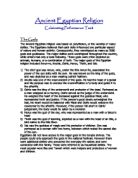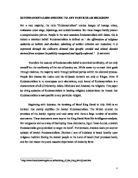Shinto
Ancient and Indigenous Religions
Beliefs In Deities (Gods) And Spirits
The Shinto religion teaches that everything contains a spiritual force, or god, which are called kami. Every object, whether it be living or non-living, contains a kami. Therefore, there are an infinite number of kami in the universe. Despite the infinite amount of kami, specific kami are worshipped. The most worshipped of all kami is Amaterasu, the Goddess of the Sun. The picture on the right shows a shrine specifically devoted to Amaterasu, the previously mentioned Goddess of the Sun.
Sacred Stories And/Or Writings
The beginning of writing the Shinto religion had a deep impact on the development of a single system of religious beliefs. In the early Nara period (710 AD to 784 AD), the Kojiki and the Nihon Shoki were written, which meant Japanese mythology was kept in records by gathering well-known fables and legends. The Kojiki, in greater detail, is a text which explains the creation of all the kami. The Nihon Shoki, like the Kojiki, begins with mythological tales, but extends into the modern events of the Shinto religion. The picture on the right shows an updated version of the Kojiki.







